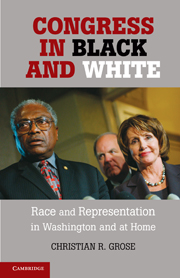Book contents
- Frontmatter
- Contents
- List of Figures and Tables
- Acknowledgments
- 1 African-American Legislators, African-American Districts, or Democrats?
- 2 A Unified Theory of African-American Representation in Congress
- 3 The “Hollow Hope” of Civil Rights Change in the U.S. House
- 4 Location, Location, Location
- 5 Constituency Service in the District
- 6 Bringing Home the Bacon
- 7 The Future of Racial Redistricting
- Appendix 1 Methods Used to Measure the Civil Rights Issue Space
- Appendix 2 Methods for Qualitative Research
- Appendix 3 Data, Methods, and Models for Project Allocations to African Americans
- References
- Index
5 - Constituency Service in the District
Connecting Black Legislators, Black Staff, and Black Voters
Published online by Cambridge University Press: 03 May 2011
- Frontmatter
- Contents
- List of Figures and Tables
- Acknowledgments
- 1 African-American Legislators, African-American Districts, or Democrats?
- 2 A Unified Theory of African-American Representation in Congress
- 3 The “Hollow Hope” of Civil Rights Change in the U.S. House
- 4 Location, Location, Location
- 5 Constituency Service in the District
- 6 Bringing Home the Bacon
- 7 The Future of Racial Redistricting
- Appendix 1 Methods Used to Measure the Civil Rights Issue Space
- Appendix 2 Methods for Qualitative Research
- Appendix 3 Data, Methods, and Models for Project Allocations to African Americans
- References
- Index
Summary
“You can't help anyone if you cannot relate.”
–An African-American staffer in Congressman Earl Hilliard's office, explaining why she thinks it is important to have African-American staff in congressional district offices.Is there a link between descriptive representation at the staff level and substantive representation at the congressional district level? What proportion of district staff are African American, white, or from other racial/ethnic backgrounds? Are these staff in the district working to reach black constituents? This chapter picks up where Chapter 4 left off, continuing to examine constituency service – a substantive, tangible good – delivered to African Americans. In this chapter, I argue that descriptive representation (the election of African-American legislators) is a key predictor of the hiring of black staff in congressional districts. Further, black staff are more likely than white staff to self-identify as being able to “relate” to African-American constituents.
Whereas members of Congress personally engage in constituency service, most of the day-to-day work dealing with casework and other services falls to the congressional staff, and most often to the congressional staff in the district. When a constituent requests assistance from their representative, typically the request goes through a staff member in one of the district offices. Legislative observers have long noted the importance of staff in assisting the representational activities of members of Congress, particularly constituency service activities.
- Type
- Chapter
- Information
- Congress in Black and WhiteRace and Representation in Washington and at Home, pp. 110 - 133Publisher: Cambridge University PressPrint publication year: 2011



